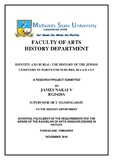Please use this identifier to cite or link to this item:
https://cris.library.msu.ac.zw//handle/11408/3326| Title: | Identity and durial: the history of the Jewish Cemetery in North End suburbs, Bulawayo | Authors: | James, Nakai Violet | Keywords: | Jews Zimbabwe Politics Jewish community |
Issue Date: | 2016 | Publisher: | Midlands State University | Abstract: | The Jews came into Zimbabwe (formerly Rhodesia) in the nineteenth century following the Second World, the Rhodesian Jewish Board of Deputies (RJBD) was established in 1943 to organize national Jewish community in the country, and thus the creation of the Bulawayo Hebrew Congregation and Jews engaged in national pioneering activities such as transportation systems, mining and hotel corporations. He further argues that the Jewish contribution to early Rhodesia was not exclusively in terms of soldiers, traders and brawlers, but certain individuals played an important part in establishing modern civilized life in Salisbury and Bulawayo engaging in politics, for instance, Ralph Harris Mayor of Bulawayo in 1979 and in 2014 Eric Bloch being an economist thus the Jews have played a pivotal role in the society of Bulawayo. The Jewish community have their own cemetery situated in North End this is due to their distinctiveness from other religions such as the Roman Catholic and the Protestants. The Jews uniqueness in rituals before and after burial and their beliefs in the Torah have made them to be separated in burial to the extent that they are neither buried with the white race. The Jewish tradition despises the use of caskets, cremation and the placing of flowers after burial as they argue that it is a pagan tradition as funerals are filled with emotions such as grief and anger that flowers symbolize a celebration. However it should be noted that the Jews instead of flowers they place stones and pebbles on the gravestones and this according to their customs symbolize love and the remembrance of a loved one. With the difference in beliefs, norms, rituals and customs it is then appropriate for the Jewish people to be buried alone as their grave stone making is different too, pictures of hands and trees are engraved, the cemetery has uniformityin the shape and width of the graves, and the Hebrew language is used on all gravestones. | URI: | http://hdl.handle.net/11408/3326 |
| Appears in Collections: | Bachelor Of Arts In History Honours Degree |
Files in This Item:
| File | Description | Size | Format | |
|---|---|---|---|---|
| DISSERTATION PROJECT NAK.pdf | Full Text | 1.33 MB | Adobe PDF |  View/Open |
Page view(s)
226
checked on Dec 20, 2025
Download(s)
106
checked on Dec 20, 2025
Google ScholarTM
Check
Items in MSUIR are protected by copyright, with all rights reserved, unless otherwise indicated.



